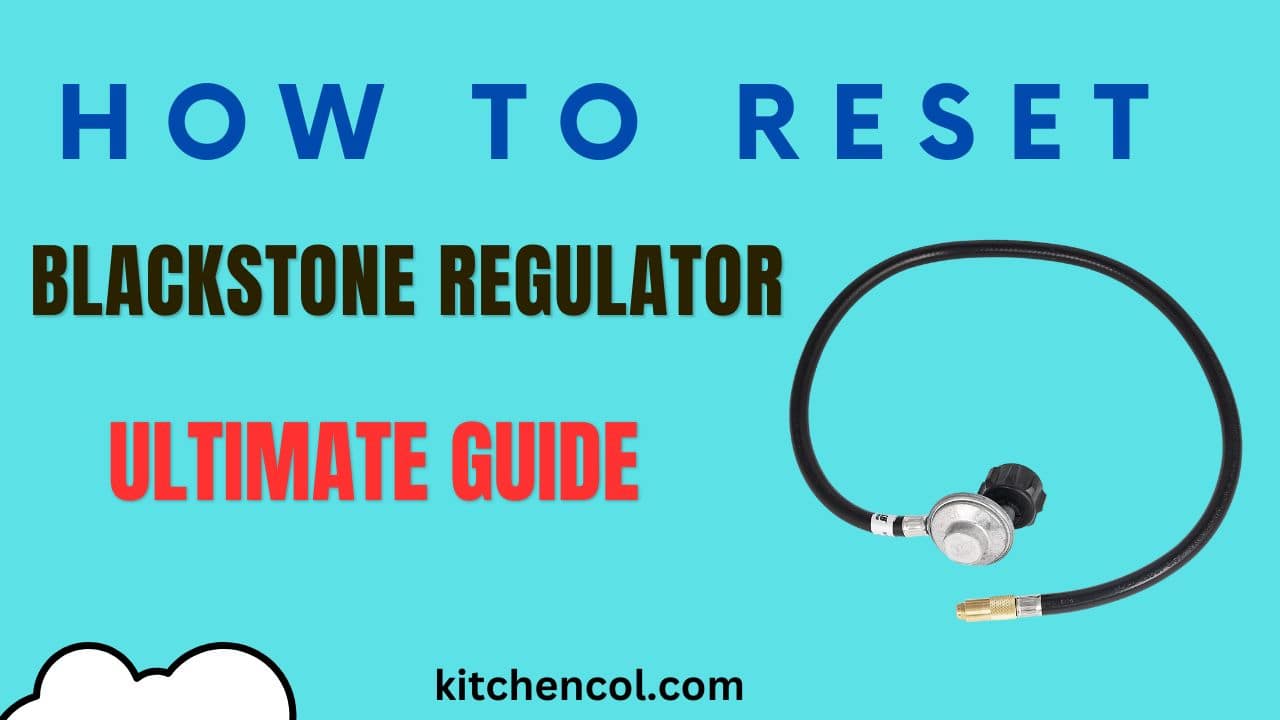A Blackstone regulator plays a crucial role in various devices, ensuring the smooth and efficient flow of gases or fluids. However, there may come a time when you need to reset the regulator to resolve issues or restore its optimal functionality. In this blog post, we will provide you with a step-by-step guide on how to reset a Blackstone regulator, ensuring that you can safely and effectively address any potential problems that may arise.
By following these instructions and taking the necessary precautions, you can confidently reset your Blackstone regulator and get your device back up and running in no time.
Understanding Blackstone Regulator Reset
Resetting a Blackstone regulator is a process that involves restoring the regulator to its default settings or clearing any error states that may have occurred. It is a common troubleshooting technique used to address issues such as erratic pressure readings, flow interruptions, or other performance-related problems.
Blackstone regulator reset can resolve various issues, including:
- Calibration Errors: Over time, a regulator’s calibration settings may become inaccurate, leading to inconsistent pressure control. Resetting the regulator can help recalibrate it and restore precise pressure regulation.
- Sensor Malfunctions: Faulty sensors can cause the regulator to provide incorrect pressure readings or fail to respond appropriately. A reset can help refresh the sensor’s settings and resolve any glitches.
- System Lock-ups: In some cases, the regulator’s internal software or firmware may encounter errors, resulting in system lock-ups or unresponsive behavior. Resetting the regulator can clear these errors and restore normal operation.
- Configuration Changes: If the regulator’s configuration has been modified, either intentionally or accidentally, resetting it will revert the settings to their default values. This is useful when troubleshooting problems arising from incorrect configuration parameters.

It’s important to note that while resetting a Blackstone regulator can address many common issues, there may be specific scenarios where other troubleshooting methods or professional assistance are required. Always refer to the manufacturer’s documentation or consult their customer support if you encounter any difficulties or uncertainties during the reset process.
Precautions and Safety Measures
Resetting a Blackstone regulator involves working with a device that controls the flow of gases or fluids. To ensure your safety and protect the integrity of the equipment, it is essential to follow these precautions and safety measures:
Familiarize Yourself:
Read the manufacturer’s manual or documentation thoroughly to understand the specific steps and precautions for resetting the Blackstone regulator. The reset procedure could differ across models.
Power Off:
Before attempting any reset, ensure that the power supply to the regulator is turned off. This prevents any accidental activation or electrical mishaps during the process.
Personal Protective Equipment (PPE):
Wear appropriate PPE such as safety goggles, gloves, and protective clothing to shield yourself from potential hazards, especially when dealing with gas or fluid systems.
Ventilation:
Perform the reset procedure in a well-ventilated area to prevent the accumulation of hazardous gases or fumes. Ensure proper ventilation to maintain a safe working environment.
Pressure Release:
If the regulator has been under pressure, make sure to release the pressure before attempting a reset. Follow the proper procedures for depressurization to prevent sudden releases of gas or fluid.
Correct Tools:
Use the correct tools recommended by the manufacturer for the reset process. Using improper tools may lead to damage or accidents. Follow any specific tool requirements mentioned in the documentation.
Untrained Personnel:
Only individuals with the necessary knowledge and training should attempt to reset a Blackstone regulator. It is advised to seek expert advice if you are unsure or uncomfortable with the procedure.
Manufacturer’s Support:
If you encounter any difficulties or uncertainties during the reset process, reach out to the manufacturer’s customer support. They can provide guidance, answer your questions, and ensure that you perform the reset safely and effectively.
By adhering to these precautions and safety measures, you can minimize risks, protect yourself, and maintain the integrity of your Blackstone regulator and the surrounding environment. Remember, safety should always be the top priority when working with any type of equipment or system.
Precautions and Safety Measures
Resetting a Blackstone regulator involves working with a device that controls the flow of gases or fluids. To ensure your safety and protect the integrity of the equipment, it is essential to follow these precautions and safety measures:
Familiarize Yourself:
Read and understand the manufacturer’s manual or documentation specific to your Blackstone regulator model. Different models may have variations in the reset process and safety guidelines.
Power Off:
Before starting the reset procedure, make sure to turn off the power supply to the regulator. This prevents any electrical mishaps or accidental activation during the process.
Personal Protective Equipment (PPE):
Wear appropriate PPE such as safety goggles, gloves, and protective clothing to safeguard yourself from potential hazards. This is especially important when dealing with gas or fluid systems.
Ventilation:
Perform the reset in a well-ventilated area to prevent the accumulation of hazardous gases or fumes. Ensure proper ventilation to maintain a safe working environment.
Pressure Release:
If the regulator has been under pressure, it is crucial to release the pressure before attempting a reset. Follow the proper procedures for depressurization to avoid sudden releases of gas or fluid.
Correct Tools:
Utilize the correct tools recommended by the manufacturer for the reset process. Using improper tools may result in damage or accidents. Follow any specific tool requirements mentioned in the documentation.
Untrained Personnel:
Only individuals with the necessary knowledge and training should attempt to reset a Blackstone regulator. It is advised to seek expert advice if the procedure makes you feel doubtful or uneasy.
Manufacturer’s Support:
If you encounter any difficulties or uncertainties during the reset process, reach out to the manufacturer’s customer support. They can provide guidance, answer your questions, and ensure that you perform the reset safely and effectively.
System Compatibility:
Ensure that you are performing the reset procedure on the correct Blackstone regulator model and that it is compatible with the intended system. Using the wrong reset method or attempting to reset an incompatible device can lead to issues or damage.
Power Supply Stability:
Before restoring power to the regulator after the reset, ensure that the power supply is stable and properly connected. Unstable power can potentially cause further issues or damage.
By adhering to these precautions and safety measures, you can minimize risks, protect yourself, and maintain the integrity of your Blackstone regulator and the surrounding environment. Remember, safety should always be the top priority when working with any type of equipment or system.
Step-by-Step Guide to Resetting a Blackstone Regulator
Follow these step-by-step instructions to safely reset your Blackstone regulator:
Identify the Location:
Locate the Blackstone regulator on your device. It is typically located near the point where gases or fluids enter or exit the system. Refer to the manufacturer’s documentation or user manual if you are unsure of the regulator’s location.
Power Off:
Before proceeding with the reset, ensure that the power supply to the regulator is turned off. This prevents any electrical accidents and ensures your safety during the process.
Reset Button or Switch:
Look for the reset button or switch on the regulator. It is usually labeled as “Reset” or indicated by an icon. Depending on the model, the precise position could change. Again, consult the manufacturer’s documentation for specific details.
Press and Hold:
Press and hold the reset button or switch. The duration for holding may vary, so refer to the manufacturer’s instructions. Typically, holding the button for around 10 to 15 seconds is sufficient.
Release the Reset Button:
Release the reset button once you’ve held it for the allotted amount of time. This initiates the reset process and clears any stored data or error states.
Power On:
Once you have released the reset button, turn the power supply back on to the regulator. Ensure that the power is stable and properly connected.
Verification:
After powering on, observe the regulator’s behavior. It should start up and initialize itself, indicating a successful reset. Monitor the device for any error messages or abnormal operations to ensure the reset was effective.
Calibration and Configuration:
Depending on the specific model and requirements, you may need to recalibrate or reconfigure the regulator after the reset. Refer to the manufacturer’s instructions for any additional steps or settings that need to be adjusted.
Remember, if you encounter any difficulties or uncertainties during the reset process, it is always recommended to consult the manufacturer’s documentation or reach out to their customer support for guidance.
By following these step-by-step instructions, you can safely and effectively reset your Blackstone regulator, resolving any issues and restoring optimal performance to your device.
Troubleshooting Tips
While resetting a Blackstone regulator can often resolve common issues, there may be instances where additional troubleshooting is required. Here are some troubleshooting tips to help you address potential problems:
No Response or Power:
If the regulator does not respond or show any signs of power after the reset, check the power supply and connections. Ensure that the power source is functioning correctly and that all connections are secure.
Pressure Irregularities:
If you notice inconsistent pressure readings or fluctuations even after the reset, verify that the input gases or fluids are at the appropriate levels and within the regulator’s specified range. Additionally, check for any blockages or leaks in the system that may affect pressure stability.
Error Messages:
If error messages persist after the reset, consult the manufacturer’s documentation for error code explanations and recommended troubleshooting steps. Follow the specific instructions provided to address the identified error.
Sensor Calibration:
Inaccurate pressure or flow readings could indicate a need for sensor recalibration. Refer to the manufacturer’s instructions on how to calibrate the sensors correctly. Follow the calibration process carefully to ensure accurate readings.
Maintenance and Cleaning:
Over time, debris or contaminants can accumulate in the regulator, affecting its performance. If the reset does not resolve the issue, consider performing a thorough cleaning of the regulator according to the manufacturer’s guidelines. Regular maintenance and cleaning can help prevent issues and ensure optimal functionality.
Firmware or Software Updates:
Check if there are any available firmware or software updates for your Blackstone regulator. Updating to the latest version can address known bugs or compatibility issues and enhance overall performance.
Professional Assistance:
If you have followed the troubleshooting tips and the issue persists, it may be necessary to seek professional assistance. Contact the manufacturer’s customer support or consult a qualified technician who specializes in Blackstone regulators for further diagnosis and repair.
Keep safety precautions in mind and follow them when troubleshooting. If you are unsure about any step or encounter difficulties, it is advisable to seek expert advice rather than attempting complex repairs on your own.
By employing these troubleshooting tips, you can effectively address potential issues with your Blackstone regulator and ensure its optimal performance.
Additional Considerations
In addition to the step-by-step guide and troubleshooting tips, here are some additional considerations to keep in mind when resetting a Blackstone regulator:
Manufacturer’s Instructions:
Always refer to the manufacturer’s documentation, user manual, or online resources for specific instructions related to your Blackstone regulator model. Manufacturers may provide model-specific reset procedures or additional precautions that need to be followed.
System-Specific Requirements:
Different systems may have specific requirements or considerations when resetting the regulator. For example, industrial systems may require specific safety protocols or shutdown procedures before performing a reset. Be aware of any system-specific guidelines to ensure a safe and effective reset.
Data Backup:
Before performing a reset, consider backing up any critical data or settings stored in the regulator. This can be especially important if the regulator has programmable parameters or custom configurations. Refer to the manufacturer’s instructions for guidance on backing up and restoring data, if applicable.
Maintenance Schedule:
Incorporate regular maintenance and inspection of your Blackstone regulator into your maintenance schedule. Preventive maintenance can help identify potential issues before they require a reset and ensure optimal performance over time. Follow the manufacturer’s recommended maintenance schedule for the regulator.
Training and Certification:
If you work with complex systems or in an industrial setting, consider obtaining proper training and certification to handle Blackstone regulators or similar equipment. Training can provide you with the necessary knowledge and skills to perform resets and troubleshoot issues safely and effectively.
Documentation and Records:
Keep detailed records of any maintenance activities, including resets, performed on the Blackstone regulator. Document the date, time, and details of the reset procedure, as well as any observations or changes in performance. This documentation can be valuable for future reference or when seeking assistance.
Warranty and Service Agreements:
If your Blackstone regulator is under warranty or covered by a service agreement, be mindful of any specific requirements or limitations related to resets. Performing unauthorized resets or repairs may void the warranty or service agreement. Check the terms and conditions and consult with the manufacturer or service provider if necessary.
By considering these additional factors, you can ensure proper maintenance, compliance with guidelines, and smooth operation of your Blackstone regulator throughout its lifespan.
Also Read: How to Fix Instant Milk Frother Not Turning On
Conclusion
In this blog post, we have provided you with a step-by-step guide on how to reset a Blackstone regulator, outlined troubleshooting tips, and discussed additional considerations. Resetting a Blackstone regulator can help resolve common issues and restore optimal performance to your device.
Remember to prioritize safety, follow the manufacturer’s instructions, and seek professional assistance when needed. By following the outlined steps and considerations, you can confidently reset your Blackstone regulator and maintain the efficiency of your system.

My name is Manan Bukhari and I am an expert in reviewing kitchen products for years. I have a passion for testing multiple gadgets especially related to home & kitchen. I love to spend my free time in resolving issues if I face some in any of my daily use things. I have fixed multiple gadgets of my home on my own without any assistance and that thing gave me confidence to make a blog on troubleshooting of items that are for daily use to assist you folks. Even my wife praises me for having such talent. I always explore new machines on my own because this thing fascinates me.



